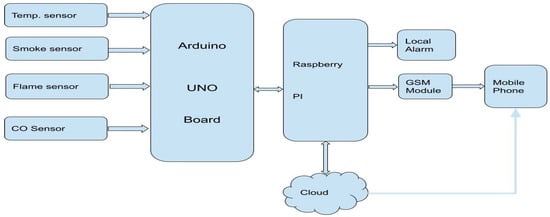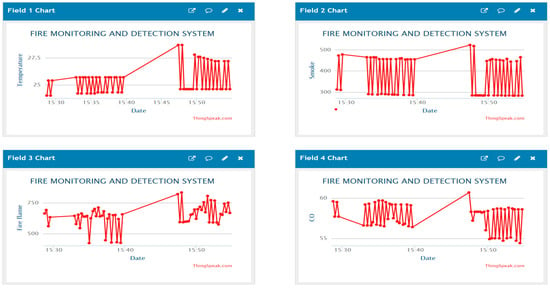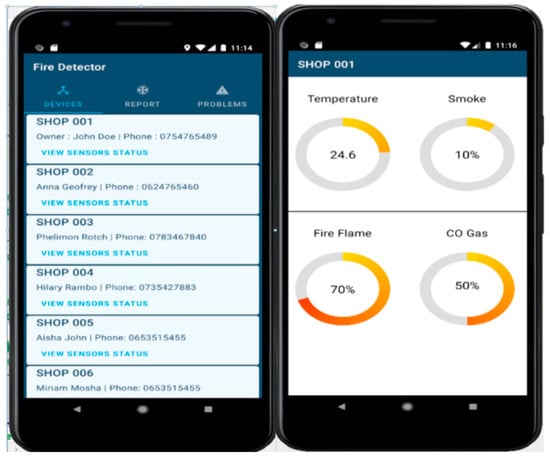Abstract
Application of wireless sensor networks (WSN) and Internet of Things (IoT) used to provide real-time monitoring of fire outbreak in markets. The system integrates three subsystems namely; sensing subsystem which uses multiple sensors for detecting fire outbreaks. Data processing subsystem which collects data from the sensing subsystem through Xbee, analyses, and uploads data to the cloud. If values exceed the sensor threshold, an alarm is triggered and notification is sent to stakeholders via mobile application subsystem. The integration between sensing, data processing, and mobile application subsystems pave a new way for the mitigation of fire outbreaks at its early stage.
1. Introduction
Market fire disaster is a repetitive challenge to various markets in East Africa [1]. It shutters the trader’s dreams and effort to overcome the poverty vicious cycle. It’s a big blow to traders socially and economically resulting in huge destruction of properties, goods, and loss of their capital for business [2,3,4]. Frequently market fire outbreaks in Tanzania particularly mwanjelwa, Sido, uhindini markets in Mbeya affected many merchants [3,5].
The efforts of developing new early fire detection systems such as smoke detection systems, fire alarm systems have been made by researchers and scientists [6,7,8]. Though there is a still gap of using integrated smart fire detection systems that operates in real-time and accurately predict fire outbreak incidents, reducing late or false notifications on fire outbreak to firefighting services hence useful in mitigating the fire disasters [9].
Through the technological development in the Internet of Things, Mobile applications, Sensor Networks. The developed system could give real-time monitoring through real-time notification of fire outbreak reducing the chance of fire spreading fast hence saving on life and property [10,11]. This system act as an early warning system where the warning and alert are directly sent to the market security guard and fire rescue team at its initial stage [12]. A combination of the sensor increases system accuracy that helps to avoid false alarms. Unlike the current systems that only give an alarm within the building; this system sends the information or notification to firefighters, security guards, and merchants at any time and anywhere to ensure a fire outbreak is contained.
2. Materials and Methods
The details of the methodology and material used from the initial stage of the project to its completion and how the system was implemented are clearly explained. One of the closed markets in Arusha, Tanzania was used as the study area namely; Maasai Market Curios and Crafts which had several fire incidents.
2.1. System Design
The system design of the project is composed of three subsystems that are integrated to provide real-time fire detection. The subsystems are the sensing system (fire detector), Data processing System (Sink Node), and Mobile Application as shown in Figure 1 below.

Figure 1.
System Architecture.
2.1.1. Sensing Subsystem
This subsystem composed of an Arduino microcontroller’s board and sensors that perform sensing functionality of fire outbreak parameters [13]. Fire outbreak parameters include temperature, carbon monoxide, smoke, and fire flame. In this case, the detector will contain the following sensors; Smoke and carbon monoxide sensor (MQ-02), temperature sensor (DHT22), and fire flame sensor to collect fire parameters (fire presence indicators). The sensors input collected data to the Arduino board for transmission to the Data processing subsystem through a wireless network [8,14].
2.1.2. Data Processing Subsystem
This subsystem receives data collected from the sensing subsystem through the Xbee transceiver, data from each node that are identified by using a special ID [10]. The main functionality of this system is for real-time processing of all sample data received from the sensing subsystem. The main functions performed by the processing subsystem are:
- Analyzing received data
- Pushing nodes data to the cloud for visualization and communication with Mobile Application
- Trigger local alarm if there is a fire outbreak
- Use a GSM module to call and send SMS during a fire outbreak
Based on real-time processed results of sample data, the node can determine the state of the shop environment and execute an alert to all defined stakeholders if there is a possibility of a fire outbreak. In this case, stakeholders include merchants, Firefighters, Electricity Power suppliers, and Security guards.
2.1.3. Mobile Application Subsystem
The mobile application pulls data from the cloud for visualization and real-time monitoring of the fire outbreak. The mobile application performs the following functions
- Visualization of data of each node in shops
- Reporting of any malfunctioning node
- Provide notification (alarm) in case of fire outbreak
3. Results and Discussion
The results of the developed system in correspondence to the objective of the project were obtained. The aim was to develop an early fire detection system to mitigate the fire disaster in markets. During the system implementation the system was made up of a sensing subsystem to sense the parameters of fire occurrence like smoke, flame, temperature, and CO, and then sensed values were pushed to the data processing subsystem. Then the data from the data processing subsystem were sent to the cloud (Thing speak) and finally to the mobile application via the internet.
3.1. Sensing Subsystem
This subsystem was interfaced correctly and it was able to work and give the results as proposed in the project. Fire outbreak parameters such as temperature, carbon monoxide, smoke, and fire flame were able to be detected accurately. The subsystem interfaced to the Xbee module; the module was configured as a transmitter for sending data to the data processing subsystem. The data transferred as a JSON object to the XBee receiver connected to the Raspberry Pi [10].
3.2. Data Processing Subsystem
The subsystem was able to receive data collected from the sensing subsystem through the Xbee receiver in which the Raspberry Pi is the sink node. The system performs two tasks on the received data, starting with an analysis of received data based on the defined sensor's threshold. If the values exceed the defined thresholds the subsystem triggers a local alarm and sends a short message (SMS) notification through the GSM module. Apart from the analysis task, the system uploads all data received from the sensing subsystem, the data are uploaded to the cloud (Thing speak) [15].
The Thing speak is an Open source data platform and API for the IoT that enables us to collect, store, analyze, visualize, and act on data from sensors or actuators, such as Arduino, Raspberry Pi, and other hardware. The visualization of data in the cloud from the sink node is as seen in Figure 2 below.

Figure 2.
Sensor data visualization dashboard.
Figure 2 shows the parameter's value from one of the end nodes displaying temperature, smoke, fire flame, and carbon monoxide values collected from the sensors.
3.3. Mobile Application Subsystem
The mobile application pulls the data from the cloud through the Application Programming Interface (API) generated through Thing Speak. The data are customized and visualized per each shop. Each shop data is visualized through a circular chart that shows the percentage of each parameter in a particular shop. In case the parameter exceeds the defined sensor threshold the mobile application will trigger an alarm with notification of a possible fire outbreak in a particular shop. Also, the mobile application can send notification of any malfunctioning sensor node [16]. The mobile application data visualization of data is as shown in Figure 3 below.

Figure 3.
Mobile Application.
3.4. Discussion
Having real-time response to fire incidence has been the challenge especially in most markets in Tanzania when a fire outbreak occurs at night. The developed mobile application allows the fire outbreak notifications to be sent at any time and anywhere to both the fire and rescue unit and the market security guards. Since the security guards are at the market it is easy for them to extinguish the fire at its early stage and rescuing properties while waiting for the fire and rescue team to reach the incidence area. This will minimize fire impacts and destruction of properties.
The developed system is cheaper and affordable, thus the shop owners at the market are willing to purchase the system as long as their properties are secured. The pain of losing the business capital at once due to fire incidence made the traders wait eagerly to use the system.
4. Conclusions
This project aimed at detecting fire outbreak at its early stage by using sensors for detecting common fire occurrence parameters such as smoke, flame, CO, and temperature. Upon detection of an increase in the sensed data of any parameter, the notification alarm is pushed through GSM short message (SMS) and mobile application system to the market security guards and fire rescue unit to respond in real-time to extinguish the fire at its early stage before it causes any destruction to properties. The mobile application can visualize the location of each shop in the market where the sensing subsystem is located thus once there is a notification alarm for a fire outbreak the security guards and fire and rescue unit can know the exact location of the fire outbreak.
The integration of the developed system between the sensing subsystem, the data processing subsystem, and the mobile application subsystem pave a new way for mitigation of fire outbreak at its early stage. Despite the distance that the fire and rescue team has to travel upon receiving the fire outbreak notification at a certain market the market security guards who are available at the markets respond in real-time by being able to receive the notification alarm and the location of the fire outbreak within the market. The developed system is of great advantage that can help early and real-time response in fire extinguish, saving lives, and property.
Conflicts of Interest
The authors declare no conflict of interest.
References
- Ngunyi, E.W. Community organizing in achieving resilience to disasters: the case of fire disaster in Gikomba market. Ph.D. Thesis, University of Nairobi, Nairobi, Kenya, 2011. [Google Scholar]
- Addai, E.K.; Tulashie, S.K.; Annan, J.S.; Yeboah, I. Trend of fire outbreaks in Ghana and ways to prevent these incidents. Saf. Health Work 2016, 7, 284–292. [Google Scholar] [CrossRef] [PubMed]
- Mwidege, A.M.; Rogath, H. Socio-economic effects of market fires outbreaks: An evidence of Mbeya City, Tanzania. Int. J. Res. Soc. Sci. 2014, 4, 321. [Google Scholar]
- ILodiuba, N.; Nwaogazie, I.L.; Ugbebor, J. Classification of Causes and Strategies for Curbing Market Fire in Nigeria. Arch. Curr. Res. Int. 2017, 7, 1–13. [Google Scholar] [CrossRef]
- Twigg, J.; Christie, N.; Haworth, J.; Osuteye, E.; Skarlatidou, A. Improved methods for fire risk assessment in low-income and informal settlements. Int. J. Environ. Res. Public Health 2017, 14, 139. [Google Scholar] [CrossRef] [PubMed]
- Cetin, A.E.; Merci, B.; Günay, O.; Töreyin, B.U.; Verstockt, S. Methods and Techniques for Fire Detection: Signal, Image and Video Processing Perspectives; Academic Press: Cambridge, MA, USA, 2016. [Google Scholar]
- Kumar, K.; Sen, N.; Azid, S.I.; Mehta, U.V. A fuzzy decision in smart fire and home security system. Proc Comput. Sci. 2017, 105, 93–98. [Google Scholar] [CrossRef]
- Kremens, R.; Faulring, J.; Gallagher, A.; Seema, A.; Vodacek, A. Autonomous field-deployable wildland fire sensors. Int. J. Wildland Fire 2003, 12, 237–244. [Google Scholar] [CrossRef]
- Idris, F.; Hashim, N.; Kadmin, A.F.; Yee, L.B. Intelligent fire detection and alert system using labVIEW. Int. J. Electr. Comput. Eng. 2019, 9, 1842. [Google Scholar] [CrossRef]
- Shu-Guang, M.A. Construction of wireless fire alarm system based on ZigBee technology. Procedia Eng. 2011, 11, 308–313. [Google Scholar] [CrossRef]
- Kahwa, R.J. Fire Emergency Preparedness at Schools: A Case Study for Secondary Schools in Moshi Rural District, Kilimanjaro Region, Tanzania; University of the Free State: Bloemfontein, South Africa, 2009. [Google Scholar]
- San-Miguel-Ayanz, J.; Ravail, N. Active fire detection for fire emergency management: Potential and limitations for the operational use of remote sensing. Nat. Hazard 2005, 35, 361–376. [Google Scholar] [CrossRef]
- Chen, T.; Wu, P.; Chiou, Y. An early fire-detection method based on image processing. Int. Conf. Image Processing 2004, 3, 1707–1710. [Google Scholar]
- Bahrepour, M.M. Automatic Fire Detection: A Survey from Wireless Sensor Network Perspective; Pervasive System Group, Univeristy of Twente. J. Atmos. Sci. 2008. [Google Scholar]
- Sarwar, B.; Bajwa, I.S.; Jamil, N.; Ramzan, S.; Sarwar, N. An intelligent fire warning application using IoT and an adaptive neuro-fuzzy inference system. Sensors 2019, 19, 3150. [Google Scholar] [CrossRef] [PubMed]
- Laizer, L.L. Assessment of Fire and Rescue Force Performance in Tanzania: Case of Dar es Salaam Region. Ph.D. Thesis, Ardhi University, Dar es Salaam, Tanzania, 2016. [Google Scholar]
Publisher’s Note: MDPI stays neutral with regard to jurisdictional claims in published maps and institutional affiliations. |
© 2020 by the authors. Licensee MDPI, Basel, Switzerland. This article is an open access article distributed under the terms and conditions of the Creative Commons Attribution (CC BY) license (https://creativecommons.org/licenses/by/4.0/).